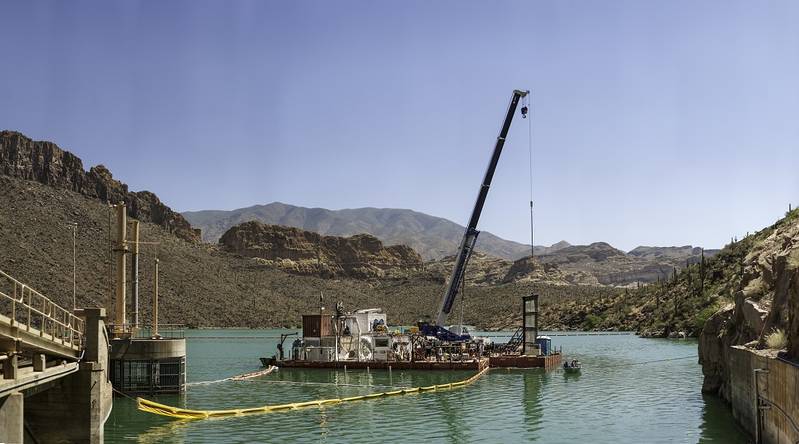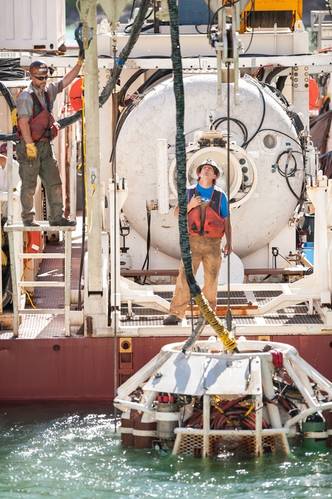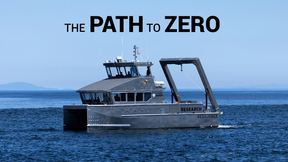Unique Horse Mesa Dam Project Nears Completion
Faced with a challenging decision between draining Apache Lake or trying a unique underwater diving method to repair the damaged intake structure for Horse Mesa Dam’s hydroelectric units, Hydro Generation engineers at Salt River Project chose the latter rather than the former, which would have significantly impacted marina operations as well as boating enthusiasts at the reservoir.
SRP said that decision is about to be rewarded as construction workers from SRP and Seattle-based Global Diving & Salvage Inc. are in the final stages of a saturation diving project that may be the only one of its kind in the world. Crews have completed the major project at Unit 4 before spending the next week finishing work on the intake structures for Units 1-3.
“We were faced with some tough choices, with a primary focus being the preservation of our valuable hydro generation pump-back unit,” said Roger Baker, a principal engineer in SRP’s Hydro Generation department and the project manager of the Horse Mesa Dam job. “We really didn’t want to lower the reservoir level by 170 feet and essentially drain Apache Lake – which we had to lower about 50 feet in 2006-07 for maintenance work that is planned every 20 years – so we looked at several other options. We’re pleased with the final result.”
The complicated project was prompted by a June 2012 collapse of a guide vane inside the penstock intake, the huge pipe that passes through the dam from Apache Lake into the generating unit below on the Canyon Lake side. The dam itself was unharmed and other structures remained sound.
The bottom-line result of the damage was the shutdown of Unit 4 and the 119 megawatts of electricity produced by the pump-back unit that was added to the dam in 1972 – 45 years after the completion of Horse Mesa Dam. And considering Horse Mesa’s generating units have the highest capacity of any of SRP’s dams – a combined 149 megawatts – the loss of Unit 4 hampered the overall operation of SRP’s pumped-storage system.
SRP utilizes the pump-back system, which also includes a unit downstream at Mormon Flat Dam, to produce hydroelectricity by pumping it back into the upper reservoir when electricity demand and cost are low and then releasing the water through the generator when demand is high.
Horse Mesa Dam was originally designed as the focal point of SRP’s electrical development when it was completed in 1927. Horse Mesa, which creates Apache Lake, is the next dam downstream on the Salt River from Theodore Roosevelt Dam. Water from Horse Mesa is released into Canyon Lake.
After a construction plan was selected, new structures for the dam had to be fabricated and a contractor that offers solutions for difficult projects such as at Horse Mesa Dam had to be selected. That’s where SRP’s Mechanical C&M (MCM) department, Global Diving & Salvage and Stantec, an engineering consulting firm that provided the options for evaluation and designed the repairs, came into the picture.
“When you are fixing one of the key dams in central Arizona, you use the best available talent,” said Baker, referring to SRP’s Tempe-based MCM group. “That’s why when new parts had to be quickly fabricated for repairs, we knew we could entrust the job to the pros in MCM. Their expertise translated into time saved by fabricating and preparing everything in-house.”
Working with designs prepared by Stantec, SRP’s MCM employees began what Austin Stewart, a section supervisor for MCM Hydro Support, called “the biggest job our group has been handed in some time” – logging about 9,000 work-hours to see the project through completion.
Global Diving & Salvage early this year set up a huge working barge on Apache Lake next to the dam. Global Diving hauled 29 tractor trailer loads that included the barge system that supports the construction efforts as well as cranes, boats and other support features. Its 20- to 24-member crew working around the clock on the barge supports the divers working under water.
When the project was at its peak, Global Diving utilized two teams of two divers working around the clock. Global Diving’s crew used a specialized technique called “saturation diving,” where the divers breathe a blend of oxygen and helium, and stay under pressure for up to 30 days. This allows the divers to work at depth for much greater periods than conventional diving allows.
While one diver remained in the diving bell, the vessel that brought them from the work area 160 feet below the surface of Apache Lake to their pressured habitat vessel on the barge, the other worked a five-hour shift. Roles were then reversed for the other five hours. Ten hours later, the second two-man crew repeated the process. To have two crews working for about 20 hours a day for 30 days, the divers remained under pressure in their barge-located pressurized chambers, in the diving bell, or at the bottom of the lake.
The new vanes fabricated and assembled by SRP’s MCM department are carbon steel forms coated with corrosion protection that are filled by underwater concrete. Global Diving’s tasks on the project included anchoring and securing the steel forms that are fortified in place by filling them with a special non-aggregate concrete mixture especially developed for underwater placement.



















